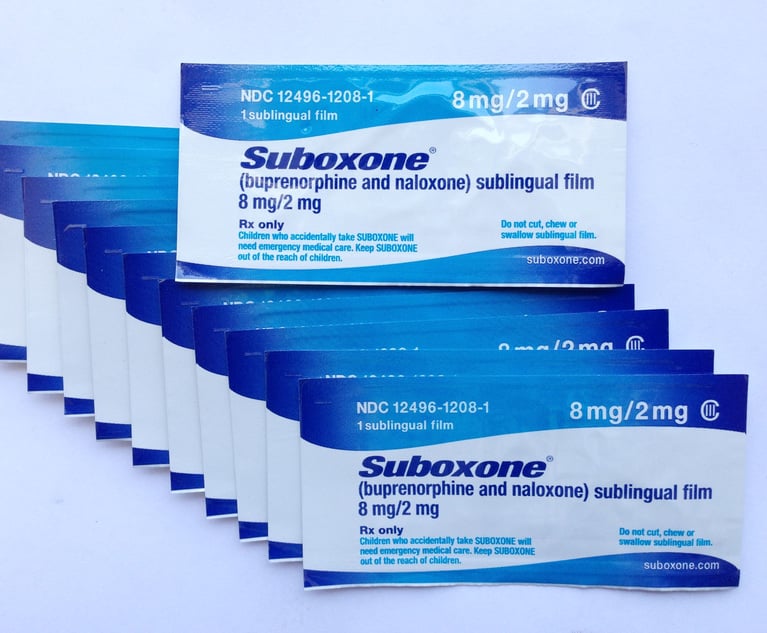Review of Personal Injury Awards: Questioning Reasonable Compensation
The jurisdiction of the Court of Appeals to review questions of fact is severely curtailed by the New York State Constitution (art. 6, § 3[a]), and the court's primary role is its law-making function, to unify, clarify and pronounce the law for the state of New York.
September 04, 2018 at 12:07 PM
9 minute read
 Thomas R. Newman and Steven J. Ahmuty Jr.
Thomas R. Newman and Steven J. Ahmuty Jr.The jurisdiction of the Court of Appeals to review questions of fact is severely curtailed by the New York State Constitution (art. 6, § 3[a]), and the court's primary role is its law-making function, to unify, clarify and pronounce the law for the state of New York. The correction of errors by the courts below in a particular case is a secondary function, though no less important to the litigants. The Court of Appeals is only likely to get involved in reviewing a personal injury award where a pure question of law is involved, such as whether the jury was properly instructed as to the factors it may consider in arriving at its award (Bryant v. New York City Health & Hospitals, 93 NY2d 592, 598 [1999]), or whether there is “no valid line of reasoning and permissible inferences which could possibly lead rational [people] to the conclusion reached by the jury on the basis of the evidence presented at trial,” as in Shubbuck v Conners, 15 NY3d 871, 872 (2010).
On the other hand, the Appellate Division is expressly granted power to “review questions of law and of fact” on an appeal from an order of the Supreme Court and to determine “that an award [of damages] is excessive or inadequate if it deviates materially from what would be reasonable compensation.” Modifying an order or judgment on the ground that the award is excessive or inadequate involves the court's error-correction function and the court should provide a sufficient factual recitation to show the basis for its decision. This will not only let the parties know that the decision was reached with full awareness of all the relevant facts, but it will enable the decision to be a guide for future cases as to what may be deemed reasonable compensation for the type of injury involved. Unfortunately, too few decisions contain a sufficient statement of the relevant facts pertaining to the plaintiff's injuries.
For more than 30 years, this column has pleaded in vain for appellate courts to include a description of the injures involved in personal injury actions where jury awards are set aside and either a remittitur or additur is directed. (see, Newman, Review of Awards in Personal Injury Cases, NYLJ, March 15, 1984, Newman & Ahmuty, Review of Personal Injury Verdicts, NYLJ, February 2, 2000, and Newman, “Damages: A Call For Meaningful Precedents,” 3 Pace L. Rev. 605 [1983]). As we said 18 years ago, “Hope springs eternal in the human breast” (Pope, “An Essay on Man”). Since the composition of the Appellate Division has changed since our last article on this subject, we renew our plea with some current illustrations of how easy it would be for the court to add a meaningful sentence or two in the decision.
We are not unmindful of the fact that some decisions already provide the relevant facts pertaining to the plaintiff's injuries, or of the staggering number of appeals and motions that each justice and panel of the Appellate Division must review and decide. However, we believe it is counterproductive for the court not to write informative decisions on the sustainable quantum of damages. It should not take much time to include a few descriptive sentences in the decision and it would probably result in the settlement of many more cases as the parties and their counsel will be better able to evaluate their case, thereby obviating the need for appellate review,
Moreover, all “opinions must be read in the setting of the particular cases and as the product of preoccupation with their special facts,” see Danaan Realty v. Harris, 5 NY2d 317, 332 (1959). Those facts should be stated for the reader's elucidation. The Legislature must have contemplated that this would be done when it enacted CPLR 5522(b) and stated that where “it is contended that the award in excessive or inadequate, the appellate division shall set forth in its decision the reasons therefor …”
Unfortunately, most of the decisions now being handed down by the Appellate Division in personal injury cases where the amount of the award is challenged are of little or no value as precedents; only the litigants involved and those interested attorneys who have access to a law library containing the records on appeal and briefs will be in a position to know the facts underlying the decision, and even they will not know which of those facts, singly or in combination, were instrumental in persuading the court to arrive at its decision.
Even justices of the Appellate Division, unless they were on the panel that decided the case, may be unaware of a relevant decision or the facts and reasoning behind it. Two panels of justices in the same Department of the Appellate Division may arrive at vastly different evaluations of cases involving similar injuries because the later panel may be unaware of an earlier decision by another panel. At present, it is extremely difficult for judges and lawyers to objectively evaluate most cases involving serious injuries. This is an unsatisfactory situation that often precludes or aborts meaningful settlement negotiations, compels judges to decide cases, as the jury does, without reference to helpful precedents, and results in more appeals being taken by dissatisfied litigants.
Only by comparison of the award under scrutiny with recent awards upheld in cases involving comparable injuries, life expectancy and earning capacity can some measure of uniformity and predictability be attained in this important area of the law. The following decisions are illustrative of the problem and show how it can easily be solved.
In Bermingham v. Atlantic Concrete Cutting, 2018 NY Slip Op 02246, 2018 WL 1526293 (1st Dept, March 29, 2018), plaintiff appealed from an order that granted defendants' motion to set aside the jury verdict awarding plaintiff $100,000 for past pain and suffering, $200,000 for future pain and suffering, $225,000 for past lost earnings, and $1,300,000 for future lost earnings, and directed a new trial on liability and damages unless the parties stipulated to reduce the awards to $50,000 for past pain and suffering, $100,000 for future pain and suffering, and $595,000 for past and future lost earnings. The Appellate Division modified, on the law and the facts, and denied the defendant's motion insofar as addressed to the verdict as to liability, reinstated the liability verdict, and directed a new trial solely on the issue of damages unless the parties stipulated to accept awards of $100,000 for past pain and suffering, $100,000 for future pain and suffering, and $700,000 for past and future lost earnings, and otherwise affirmed. In other words, the Appellate Division disagreed with the trial court's reduction of the jury's award for past pain and suffering to $50,000 and restored the $100,000 verdict, agreed with the trial court's reduction for future pain and suffering to $100,000, and disagreed with the trial court's reduction of the award for past and future lost earnings and increased it from $595,000 to $700,000—all without any recitation of the relevant facts or explanation for any part of ts decision, other than the required formulaic statement that “the noted awards deviated materially from what would be reasonable compensation.” Why?
In Jones v. New York Presbyterian Hospital, 158 AD3d 474, 67 NYS3d 835 (1st Dept, Feb. 8, 2018), the trial court granted the defendant's motion to reduce the jury's damages awards, and ordered a new trial on damages unless the plaintiff stipulated to reduce the award for past pain and suffering from $600,000 to $150,000 and the award for future pain and suffering over a five-year period from $400,000 to $150,000. The Appellate Division, unanimously modified, to order a new trial on damages for past pain and suffering unless plaintiff stipulated to reduce the award for such damages to $400,000, and affirmed the trial court's reduction of the verdict for future pain and suffering to $150,000. The court stated the relevant facts and explained the basis for its decision.
As a result of the defendant's negligence, the plaintiff suffered a comminuted proximal humerus fracture, which healed in a misaligned manner. The injury resulted in chronic pain and a permanent reduction in the plaintiff's range of motion and has had a significant impact on the plaintiff's quality of life, as she remains unable to care for herself.
Under these circumstances, an award for past pain and suffering in excess of $400,000 deviates materially from what would be reasonable compensation (see CPLR 5501 [c]), and we modify the Supreme Court's order accordingly.
In light of the plaintiff's age (84 when injured and 89 at the time of the trial), Supreme Court correctly determined that an award for future pain and suffering in excess of $150,000 deviates materially from what would be reasonable compensation. (67 NYS2d at 835).
“Lawyers and judges can do no more than make an intelligent guess as to the extent of pain and losses consequent upon personal injury as there is no slide rule available to accurately gauge them,” (Cole v. Long Island Lighting, 196 NYSupp. 287, 295 [Sup.Ct. Kings Co. 1959]). That truism, however, merely reinforces our belief that an effort should be made at more articulation of the grounds for decision so as to afford the litigants, their attorneys and judges, both trial and appellate, some basis for arriving at a measure of predictability and uniformity in the law of damages in personal injury and wrongful death actions.
Thomas R. Newman is of counsel to Duane Morris and author of “New York Appellate Practice” (Matthew Bender). Steven J. Ahmuty Jr. is a partner at Shaub, Ahmuty, Citrin & Spratt. They are members of the American Academy of Appellate Lawyers.
This content has been archived. It is available through our partners, LexisNexis® and Bloomberg Law.
To view this content, please continue to their sites.
Not a Lexis Subscriber?
Subscribe Now
Not a Bloomberg Law Subscriber?
Subscribe Now
NOT FOR REPRINT
© 2025 ALM Global, LLC, All Rights Reserved. Request academic re-use from www.copyright.com. All other uses, submit a request to [email protected]. For more information visit Asset & Logo Licensing.
You Might Like
View All

What Businesses Need to Know About Anticipated FTC Leadership Changes
7 minute read
Trending Stories
- 1'Ridiculously Busy': Several Law Firms Position Themselves as Go-To Experts on Trump’s Executive Orders
- 2States Reach New $7.4B Opioid Deal With Purdue After SCOTUS Ruling
- 3$975,000 Settlement Reached After Fall on Sidewalk
- 4'Where Were the Lawyers?' Judge Blocks Trump's Birthright Citizenship Order
- 5Big Law Sidelined as Asian IPOs in New York Are Dominated by Small Cap Listings
Who Got The Work
J. Brugh Lower of Gibbons has entered an appearance for industrial equipment supplier Devco Corporation in a pending trademark infringement lawsuit. The suit, accusing the defendant of selling knock-off Graco products, was filed Dec. 18 in New Jersey District Court by Rivkin Radler on behalf of Graco Inc. and Graco Minnesota. The case, assigned to U.S. District Judge Zahid N. Quraishi, is 3:24-cv-11294, Graco Inc. et al v. Devco Corporation.
Who Got The Work
Rebecca Maller-Stein and Kent A. Yalowitz of Arnold & Porter Kaye Scholer have entered their appearances for Hanaco Venture Capital and its executives, Lior Prosor and David Frankel, in a pending securities lawsuit. The action, filed on Dec. 24 in New York Southern District Court by Zell, Aron & Co. on behalf of Goldeneye Advisors, accuses the defendants of negligently and fraudulently managing the plaintiff's $1 million investment. The case, assigned to U.S. District Judge Vernon S. Broderick, is 1:24-cv-09918, Goldeneye Advisors, LLC v. Hanaco Venture Capital, Ltd. et al.
Who Got The Work
Attorneys from A&O Shearman has stepped in as defense counsel for Toronto-Dominion Bank and other defendants in a pending securities class action. The suit, filed Dec. 11 in New York Southern District Court by Bleichmar Fonti & Auld, accuses the defendants of concealing the bank's 'pervasive' deficiencies in regards to its compliance with the Bank Secrecy Act and the quality of its anti-money laundering controls. The case, assigned to U.S. District Judge Arun Subramanian, is 1:24-cv-09445, Gonzalez v. The Toronto-Dominion Bank et al.
Who Got The Work
Crown Castle International, a Pennsylvania company providing shared communications infrastructure, has turned to Luke D. Wolf of Gordon Rees Scully Mansukhani to fend off a pending breach-of-contract lawsuit. The court action, filed Nov. 25 in Michigan Eastern District Court by Hooper Hathaway PC on behalf of The Town Residences LLC, accuses Crown Castle of failing to transfer approximately $30,000 in utility payments from T-Mobile in breach of a roof-top lease and assignment agreement. The case, assigned to U.S. District Judge Susan K. Declercq, is 2:24-cv-13131, The Town Residences LLC v. T-Mobile US, Inc. et al.
Who Got The Work
Wilfred P. Coronato and Daniel M. Schwartz of McCarter & English have stepped in as defense counsel to Electrolux Home Products Inc. in a pending product liability lawsuit. The court action, filed Nov. 26 in New York Eastern District Court by Poulos Lopiccolo PC and Nagel Rice LLP on behalf of David Stern, alleges that the defendant's refrigerators’ drawers and shelving repeatedly break and fall apart within months after purchase. The case, assigned to U.S. District Judge Joan M. Azrack, is 2:24-cv-08204, Stern v. Electrolux Home Products, Inc.
Featured Firms
Law Offices of Gary Martin Hays & Associates, P.C.
(470) 294-1674
Law Offices of Mark E. Salomone
(857) 444-6468
Smith & Hassler
(713) 739-1250







